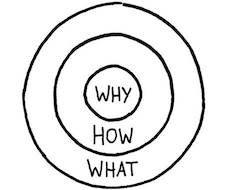Plenty of times in the past I’ve had an idea for a project, blasted out of the gates sketching rough designs, then started to build something as quickly as possible. And nearly every time I’ve not finished the project or I’ve realised that people don’t really need it so I’ve stopped in my tracks.
With the challenge I’m keen to put more structure around my thinking processes; applying the techniques & skills I’d use on a client project, and this time not rush into building something.
Starting with Why

When we were building BorrowMyDoggy, we were fortunate to get some great angel investors. One suggested we read a few books that helped him, including Simon Sinek’s Start with Why. Unfortunately, I didn’t get round to reading it back then, but recently picked it up and thoroughly enjoyed it.
His message of establishing and sticking to the 'Why' of building a business or product really resonated, and I realised that we had implemented some of it with BorrowMyDoggy, but missed so much other important elements.
Vision, Mission, and Value statements
One of the things we did right at the start of BorrowMyDoggy was to sit down and work out what our values were. We also got a handle on what our mission and vision were going to be.
I can still remember the big sheet of paper that my cofounders had sketched on as we were talking, and how great it felt to know the direction in which we were heading. These notes helped to define everything from our tone of voice (so many dog puns!), through to the clear message we had for the press when they came calling.
There are lots of guidelines out there on how to write vision and mission statements, and what the differences between the two are, so I won’t expand on them right now.
I’ve spent some time this week writing out some of my thoughts about why I’m focussing on the product I’ve chosen. I’ve got fairly clear vision and mission statements, and have put together a list of values that are important to me at this time.
I’m mindful that they’re not chiseled in stone and will likely evolve in the future, but they’ve been a useful tool to help me focus.
Should I care about what everyone else is doing?
In his fantastic talk 20 Years of Product Management in 25 Minutes, Dave Wascha gives some great insights in to his wealth of experience leading product teams and building products.
As part of his presentation Dave explains that it’s important to know what your competitors are doing, so that you can see what insights they have into your market. But then on the flip side he advises you to stop looking at your competitors as a source of innovation or execution.
I’ve not done a competitor research piece for a while, so I’ve dug up old notes about competitor analysis and understanding the current market.
What to capture as part of competitor research
Over the years, I’ve tried to simplify my approach to competitor research, and now break it down in to several major areas:
Platforms
How do their customers interact with them? Do they have a Web app, and/or Mobile apps?
Features
The ones they mention on their website and talk about in the press. What do their customers rave about? What do they complain about?
Revenue model
Freemium, Subscription, One Time Purchase, Add-ons etc
Social Media presence
Which platforms, how many followers, the regularity of posting
Content Marketing
Do they have a blog, or write articles? What area of the press write about them?
Advertising
Do they advertise online? Where do they advertise? Do they run display ads, or just text ads?
Customer reviews
What are their star ratings? Are there any common themes that appear in written reviews?
I generally get all these down in some kind of document that I can refer back to at some point; this data is very useful in a pitch deck to investors, or when you’re bringing someone new on to the team.
Looking at all this data can be a bit overwhelming when you’re just starting out. I know I struggled this week when looking at the various competitors and what they’ve built already. I’m working hard to squish that worrying voice in the back of my head :)
And once I feel like I have an understanding of the wider competitor landscape, I try to forget about them. I may refresh and revise the data every once in a while, but getting distracted by what competitors are doing is similar to comparing my work-in-progress with some one else’s finished product… Not exactly healthy!
This week has been really exciting, getting some decent foundations laid, and seeing all the opportunities to improve on what the competition have been doing. Next week is going to be focussed on product and features that will go in to the first version of the app.
